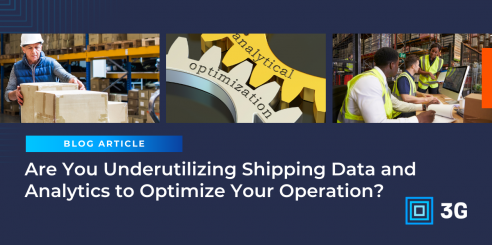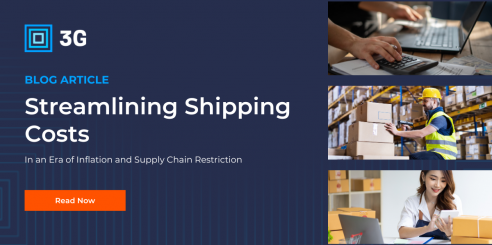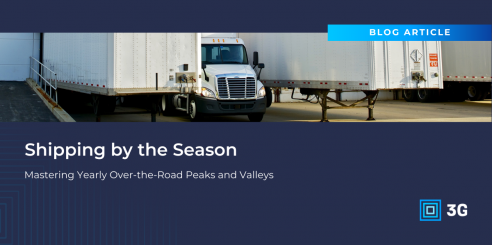Blog
3PL Software: Revolutionizing Operations For Providers

The traditional logistics model faces several significant inefficiencies, often characterized by manual operations and disjointed communication systems. 3PL software eliminates many of these by providing sophisticated procurement, warehousing, transportation, and customer service solutions. By automating and optimizing these processes, 3PL software can significantly reduce the risks of errors and delays that are often part and parcel of manual systems. It enhances route planning, offers real-time visibility into logistics operations, and supports data-driven decision-making, sometimes leading to significant cost reductions.
81% of shippers prioritize service quality in their 3PL partnerships, compared to 19% who consider cost as the primary factor – and this is skewing more towards service each year. This trend underscores the growing importance of quality service delivery in the 3PL industry, reflecting a broader recognition of the value added by these sophisticated logistics solutions.
Challenges in Traditional Logistics
The third-party logistics industry is complex and involves numerous processes, such as procurement, production, sales, inventory management, warehousing, transportation, and customer service. Traditional third-party logistics services are when a business manually carries out the entire process and uses conventional communication methods.
Because everything is done manually, there is a high risk of limited visibility and inefficiencies in route planning. Phone calls, spreadsheets, and paper-based systems often slow down processes and cause errors and delays, increasing expenses.
Traditional third party logistics providers face many challenges that often lead to inefficiencies, such as:
- Increased Risk of Delays and Errors: Many businesses still rely on traditional logistics operations that use paper-based documentation, manual data entry, and phone calls for communication, which are very slow but significantly increase the risk of delays and human error.
- Inefficient Route Planning: Route planning can be less than optimal and time-consuming when no intelligent systems can offer assistance, leading to more significant fuel spending and further delays.
- Lack of Real-Time Visibility: Without a centralized system for tracking processes like inventory management, shipments, or the location of delivery vehicles can be problematic, leading to the lack of real-time information, which increases the risk of mismanagement.
- Lack of Data-Driven Decision-Making: The absence of real-time analytics and insights such as inventory levels, staff performance, and other crucial business information often results in inefficiencies and complex decision-making.
These inefficiencies negatively impact different aspects of the business, namely cost reduction, which can lead to:
- Increased Operational Costs: Doing everything manually means higher labor and inefficient routes mean higher fuel costs, which increases the business’ overall expenses.
- Delays and Inaccuracies: As mentioned, manual processes cause a lack of real-time visibility, which can negatively impact inventory levels and shipments.
- Customer Dissatisfaction: Customers expect a fast and smooth purchase process, from ordering to delivering the product. Inefficiencies in the logistics chain may cause missed deadlines and incorrect shipments, which increases the risk of dissatisfied customers and even loss of business.
The Role of 3PL Software in Transforming Operations
3PL software enables third-party logistics companies to execute supply chain logistics, warehousing processes, and fulfillment for one or more clients. This can include processes such as receiving, putaway, picking, packing, shipping, inventory management, returns, and replenishment, all of which can be integrated with other solutions to streamline operational data further.
Third-party logistics software links the various aspects of operations, such as e-commerce channels, accounting software, shipping carriers, fulfillment centers and networks, and more. It provides businesses with the control and end-to-end visibility they need for optimal operations while providing customers with order statuses and insights.
Good 3PL software is characterized by advanced automation capabilities that provide businesses with efficient fulfillment options, fulfill clients’ budgets, and meet customers’ delivery expectations.
Key Features and Capabilities of 3PL Software
While features vary with individual 3PL systems, the typical features and capabilities of 3PL software include:
- Order Management: Enables efficient processing and tracking of orders and provides real-time updates to internal teams and customers.
- Inventory Management: Provides accurate inventory tracking to manage multiple locations and inventory forecasts to avoid overstocking or stockouts.
- Warehouse Management: Manages the warehouse layout, organizes inventory, and streamlines warehouse processes such as picking, packing, and shipping.
- Transportation Management: Manages and tracks shipments in transit and optimizes routes for cost-effective transportation.
- Billing and Invoicing: Automates billing and invoicing for all services the business provides and tracks and charges for handling, storage, and transportation costs.
- Analytics and Reporting: Monitors KPIs and produces data-driven insights that can benefit decision-making and continuous improvement.
- Visibility for Clients and Customers: Clients can view their inventory, orders, and shipments in real-time, which enhances transparency and contributes to customer satisfaction.
- Integration Capabilities: Businesses can easily integrate the software with other systems, such as ERP systems and e-commerce platforms, and set up data exchange and workflow automation, which enhance efficiency.
- Regulatory Support: Manages compliance for specialized products (like hazardous materials) and ensures that operations adhere to industry-specific standards and regulations.
- Customization and Scalability: Enables customization to accommodate specific needs of supply chain management and individual clients, adapts to evolving business needs, and accommodates expanding client base and increases in inventory and orders.
Advantages and Impact on Efficiency
Streamlines Order Fulfillment
3PL software solutions automate crucial processes in the supply chain and integrate other systems, saving business and logistics service providers time. As a result, the order fulfillment process is streamlined, from procurement to delivery.
Outsourcing these processes and utilizing automation speeds up various functions and reduces manual effort and errors by taking on repetitive and time-consuming tasks. Automation also enables businesses to stay on top of each process and ensures that everything goes smoothly, resulting in quicker order processing and delivery. Lastly, automation helps to streamline processes and improve the customer experience, as they can view real-time updates on their orders.
Enhances Inventory Management
Hiring a 3PL company typically means getting access to advanced inventory management systems. Through these specialized systems and advanced technologies, 3PL software provides real-time visibility and control over inventory levels, optimizes routing, identifies areas of improvement, and resolves inefficiencies quickly.
Its real-time insights and tracking data lower the risk of order errors, minimize stockouts, reduce excess inventory, and improve overall inventory turnover rates. Real-time visibility allows businesses to adapt to changing demands and make timely adjustments.
Improves Customer Communication and Satisfaction
3PL software can track orders and payments from start to finish, and it offers sophisticated tracking systems, which enable customers to view accurate and timely updates on their orders in real-time and make returns easily. It also provides enhanced communication channels that facilitate interaction between the business and its customers so inquiries and concerns are addressed promptly.
Through the software, businesses can offer their customers expedited shipping options like same-day, one-day, and two-day shipping. These features help instill trust and reliability, make cost savings, enhance customer experience, and improve customer retention.
Integration with Emerging Technologies
The 3PL landscape continuously evolves; cutting-edge technologies such as the Internet of Things (IoT) and Artificial Intelligence (AI) profoundly affect its transformation.
IoT is a network of interconnected devices that collect and exchange data and has technology that enables communication between devices and the cloud. AI is the ability of machines to simulate human intelligence, allowing them to learn, reason, and even make decisions. These technologies play an essential role in improving the capabilities of 3PL software and revolutionizing the logistics sector.
The Internet of Things (IoT)
3PL software that IoT powers utilize sensors and connected devices that are embedded in products, warehouses, and vehicles to collect real-time data. These data include information on environmental conditions, inventory levels, shipment statuses, and more. The large quantities of data collected by IoT allow 3PL providers to use the information to optimize every step of their logistics operations.
Artificial Intelligence (AI)
Integrating AI in 3PL software helps analyze vast amounts of data and extract actionable insights to improve third-party logistics operations. AI is equipped with predictive analytics that forecasts demands, optimizes routes, and facilitates proactive maintenance, enhancing efficiency, transparency, and decision-making within the supply chain.
The predictive models derived from these analytics also identify possible disruptions to the supply chain before they occur.
Automation and Robotics in Warehouse Management
Integrating IoT and AI with 3PL software facilitates easy automation and robotics in supply chain processes. IoT-enabled robotics help in warehouse operations through the use of autonomous vehicles, intelligent machines, and drones. On the other hand, AI-driven algorithms automate routine tasks like picking, packing, and inventory management, increasing speed and accuracy.
Overcoming Implementation Challenges
Like any other innovation, the implementation of 3PL software has its challenges. However, these common hurdles can easily be mitigated with the right strategies.
Common Challenges in Adopting 3PL Software
- Resistance to Change: Many employees may be accustomed to the traditional way of doing things, and their initial resistance can hinder adoption.
- Integration Problems: Introducing new software to existing systems might pose compatibility issues, which can lengthen the adoption process. Problems may arise, including differing file formats, incompatible functionalities, and data transfer challenges between the systems.
- Inadequate Training: Insufficient employee training on the software’s features and functionalities can contribute to acceptance, which may result in inefficiencies and underutilization.
Strategies for a Smooth Transition and User Adoption
- Employ Transition Strategies: To help employees overcome resistance, the company should initiate change management programs and provide comprehensive training on the new software. The benefits of the software must be communicated, concerns must be addressed, and employees must be involved in the transition process to build their confidence.
- Collaborate with the Software Provider: To address integration problems, close collaboration between the software provider and the company’s IT team is necessary. Planning, testing, and clear communication are needed to ensure that compatibility issues are ironed out. Resources like help desks, online tutorials, and user guides can facilitate quick software adoption.
- Provide Training Programs: To guide and better inform employees about the new software, comprehensive training must be provided to employees of all levels. Training should highlight the software’s benefits and, at the same time, educate employees about its technical aspects.
It would also help businesses implement the 3PL software in phases, for example, in specific departments before full-scale implementation. This approach will enable companies to minimize disruptions and address initial concerns before a full expansion.
Future Trends in 3PL Software
With the logistics industry continuing to evolve rapidly and experiencing substantial growth, 3PL companies and software alike are expected to witness the emergence of new technologies and trends. Expected trends include:
- Predictive Analytics and Forecasting: 3PL software is expected to continuously rely on predictive analytics and forecasting, as it can provide accurate insights into future demand patterns for better decision-making, improved resource allocation, and swift adaption to market fluctuations.
- Artificial Intelligence (AI) and Machine Learning (ML): In less than ten years, AI and ML should be an integral part of the 3PL supply chain management with features like demand forecasting, inventory optimization, and route planning.
- Advanced Robotics and Automation: Operational costs and labor shortages have persisted, so using advanced automation and robotics will become increasingly essential. These innovations will not only address problems with expenses and labor but will also significantly improve efficiency and reduce human error.
- Blockchain Technology: This technology offers a secure, transparent, and tamper-proof record of transactions that should improve transparency and traceability in the supply chain, enhance data sharing, lower risks of disputes, and identify quick solutions to issues.
- Sustainable Initiatives: The 3PL industry is predicted to increase its focus on sustainable practices. With an increasing demand for eco-friendly services, 3PL software incorporates features supporting sustainable logistics, such as optimizing transportation routes for reduced emissions, tracking carbon footprint, and improving visibility into supply chain sustainability metrics.
Other notable technologies expected to integrate into 3PL software solutions include Augmented reality (AR), Virtual reality (VR), and drone-based delivery systems.
Security and Compliance Considerations
When utilizing 3PL software, businesses should utilize data security because of the sensitive nature of the information involved. Data protection involves implementing strict measures within the software, encryption protocols to safeguard against possible breaches, and stringent access controls to prevent unauthorized access.
In addition, 3PL software must ensure data integrity, traceability, and transparency through comprehensive documentation. This way, employees can track and validate sensitive data handling, contributing to compliance and building trust among clients and partners.
Another essential aspect to prioritize when using 3PL software is compliance with industry standards and regulations. Adherence to regulatory bodies such as GDPR and HIPAA or industry-specific standards ensures that operations align with guidelines, promote safety, and avoid penalties. Regular audits and assessments of the software framework must be performed to check compliance and to determine if there are areas for improvement.
Selecting the Right 3PL Software
Here are the main factors to consider when choosing a software solution:
- Latest Technology: A business should select a 3PL provider with access to the latest technology and utilize software that includes Enterprise Resource Planning (ERP) and Transportation Management Systems (TMS) that can comprehensively manage their logistics operations. The latest 3PL software can help businesses cut expenses by streamlining processes and reducing errors through automation.
- Scalability: It’s essential to consider the software’s flexibility and scalability. All businesses have the potential to change or grow in the future, and the software should be configurable and adaptable to meet the business’s evolving needs. This includes additional facilities, increased order volumes, new locations, and more.
- Integration with Existing Systems: Finding software compatible with the business’s existing systems is essential. Seamless integration enables easy data synchronization that eliminates the need for manual processes, reducing errors and improving efficiency. Seek the assistance and support of the software provider for customization and integration.
- Compliance and Security: Make sure that the chosen software prioritizes compliance and security and has features such as data encryption, strict access controls, and regular system backups. On top of that, the 3PL software should comply with industry regulations to safeguard sensitive information, ensure that goods are correctly labeled, and protect the rights of consumers.
- Support for Multiple Client Accounts: Multiple divisions are going to use the 3PL software, and several employees may need access to real-time data at the same time, so the software should be able to offer multiple user accounts, which may also increase collaboration and ensure that employees can access the information they need simultaneously.
Industry Best Practices
Build a Strong Foundation
A strong foundation is essential when implementing 3PL software. We often see that businesses need to define their company’s logistics needs before implementing a 3PL software solution. As a result, they usually end up with incompatibilities and inefficiencies.
The best approach would be to build a strong foundation – carefully identify the areas of your logistics company that need improvement and begin from there. It’s also important to remember that these logistics solutions are about improving processes and enhancing relationships with customers.
Be Ready for Change
Integrating 3PL software solutions means a significant shift in a business’s workflow.
Because 3PL software is developed according to best practices, expect significant changes in how things are done around the company, which employees should prepare for.
However, with the proper implementation practices, including testing and comprehensive training, adopting the software’s changes will be more accessible for everyone.
Ensure Effective Communication
Implementing 3PL software will affect all departments, not only the IT, logistics, and supply chain departments, as most businesses think. This makes communication highly important, making the product adoption effective throughout the organization.
All employees must be appropriately informed and undergo training to know and understand how the software can affect their jobs. Even if the software is user-friendly, employees of all levels must be knowledgeable about it.
Make Sure that the Technology is Supported
A significant obstacle to supply chain digital transformation is when businesses and employees lack an understanding. Once integrated, the company must provide all personnel with the proper support in using the software.
Collaboration with the IT department and providing sufficient resources will significantly contribute to everyone’s understanding and ultimately improve the business’s logistics operations.
The Bottom Line on 3PL Software
3PL software has proven to be a transformative tool in logistics that enhances the efficiency of various processes in the modern supply chain while lowering expenses and reducing errors. As a result, businesses can focus their time and resources on other important matters such as product development, strategy building, and marketing.
3PL companies must be open and continue embracing innovations and technological advancements, essential for sustained success, as they encourage businesses to adapt to a rapidly changing and competitive sector. More importantly, these technologies help businesses build stronger and more transparent relationships with their clients and customers.
As the logistics landscape continues to change, 3PL companies must leverage new technologies to enhance their services, better serve their clients, remain compliant with standards and regulations, and surpass the expectations of businesses in this highly modern time.
By utilizing 3PL software solutions, small businesses can remain competitive and relevant.


